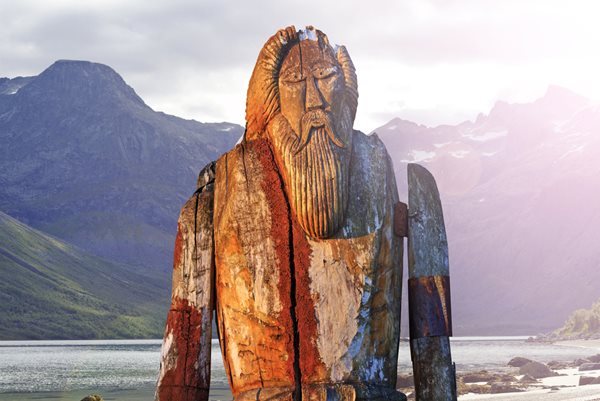
The rise in popularity of Viking culture thanks to recent television series and popular computer games has led to a welcome renewal of interest in the fascinating world of Norse mythology. Schooled in the Judeo-Christian and Greco-Roman traditions, we often do not realize how ingrained the Norse traditions are in our language and culture. The days of our midweek, for example, do homage to four beloved Norse deities. Tyr, the god of war and justice is remembered in the word “Tuesday.” Odin or Wodon, the patriarch of the Norse gods, is celebrated in Wednesday, while Thursday honors Thor, the god of Thunder just as Friday recalls Frigg or Freya, the female goddess associated with love and fate.
The Norsemen were risk-takers, daring rough seas, glaciers, and unknown lands in a never-ending drive for power and wealth that expanded their horizons from North America to Baghdad. Quest and conflict lie at the heart of the stories they invented about the gods of Asgard and Vanaheim, pitted in an eternal struggle with the giants of Jotunheim. The Nordic people lived challenging lives in harsh weather conditions. Their landscape included mountains, rivers, oceans, volcanoes, geysers, and thick forests and they captured the wonder they felt about the world around them in their foundation myths.
The universe for the Norsemen was composed of nine worlds held in the branches, leaves, and trunk of Yggdrasil, the world-tree. Asgard, Vanaheim, and Jotunheim were three of the worlds, as well as Alfheim, the world of elves and Svartalfheim, the world of dwarves. Hel was both the goddess of the dead and the land in which they dwelt. Midgard was the world of humans. The remaining two worlds are Niflheim, a world of ice, and Muspelheim a world of fire. These two worlds existed before anything else with a massive void between them, but gradually frost from Niflheim and vapor from Muspelheim began to form Ymir, a hermaphrodite being who was able to reproduce himself. Ymir was ultimately killed by his descendants Odin and his brothers, who then set about constructing the world as we know it.
The gods of Asgard, like their Greek and Roman counterparts, have individual personalities, very human likes and dislikes, and are responsible for various aspects of nature. Thor is closely associated with defending the weak but also with fertility and abundance. Frigg or Freya weaves the fate of men and gods and has power over love and desire. Perhaps the best known of the Norse gods, the irreverent nihilistic Loki, is a thorn in everyone’s side. Heimdall guards the gates of Asgard with his keen eyesight, ready to sound his horn Gjallarhorn if he sees giants on the march.
Odin presides over it all as the ruler of Asgard, though he is often away from his seat searching the world for truth and wisdom. He also watches out for exceptional warriors who fight and die heroically. These fortunate few he brings after death to Valhalla, where they fight all day but in the evening their wounds are miraculously healed and they feast all night. Odin keeps these warriors as back up troops in the final fight he knows he will wage against his enemies.
The Norse creation myth has an analogous destruction myth in the concept of Ragnarok, a final— and inevitable— clash between the gods and giants in which everyone and everything will be destroyed. Odin and his warriors, Freya and Sif, Thor, Loki and all the gods of Asgard perished. All was lost save for two humans, Lif and Lifthraisir, who represent the life force of regeneration.
Learn more about this fascinating pagan religion by reading Neil Gaiman’s bestselling
Norse Mythology; The Sagas of Icelanders, and Daniel McCoy’s authoritative
The Viking Spirit. Fans of the Marvel series and the works of J.R.R. Tolkien will recognize many of the stories and personalities listed here.
Alexander + Roberts offer a range of itineraries to the Nordic countries, including
Iceland tours,
Finland tours, and
Norway tours. Speak to one of our expert reservation agents about your trip to modern-day Midgard!